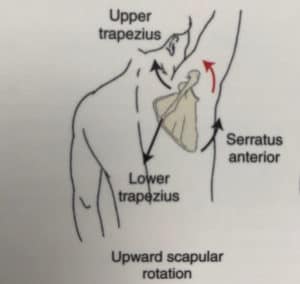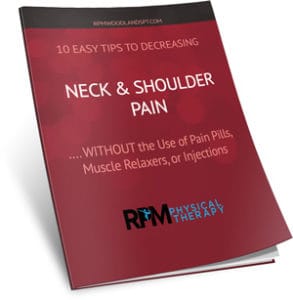
How can you improve your posture? This question is asked to me all the time from the housewife to the woman or man that sits at a desk for a significant number of hours throughout the day. Most of us that work a desk job will sit at a computer for 40, 50 or even 60 hours of our week.
Our Problem?
We sit too long at computers.
If you sit for long periods throughout the day we aren’t expecting big changes to your daily routine in those regards but if you aren’t doing something to change it by increasing the counteracting muscles, then there are a lot of negative things that will progress over time in your body. Like…
Shoulder Impingement…
Shoulder impingement is an injury caused by a few different factors converging together. If you sit in an office gremlin type of position with your shoulders hunched over then your shoulders will adaptively shorten. Shoulder impingement caused by sitting at a computer is extremely prevalent in our population and affects important muscles which ruin our posture. We see a new case in the clinic almost every week.
The Good and Bad
Bad muscles for shoulder elevation:
The pec minor (Fig. 1) will start to get tight and impede the ability for you to raise your arm over your head because the muscles that you need to do upward rotation or raise your arm overhead are inhibited by the pec minor. The function of the pec minor is to give us the ability to reach behind our back but when we sit hunched over for long periods of time (like I am trying to avoid while writing this) this muscle gets tight and starts to hold a shorter position, again, impeding function of the “good muscles” for the shoulder.

Pec Minor
Good muscles for shoulder elevation:
The serratus anterior, upper trap and lower trap (Fig. 2) need to all move in a fluid motion to efficiently raise the arm above the head and if they do not then we start to pinch the rotator cuff. The impingement of the rotator cuff causes pain and dysfunction that leads to high levels of swelling. We don’t see the swelling in the shoulder because of how deep the joint is but the sharp pain with lifting and dull feeling in the shoulder throughout the day is an indicator of the problem.

Upward Rotators of the Shoulder
Neck pain with sitting is a serious problem and it will cause you to hear the phrase, “you hold stress in your shoulders. The weight of your head doubles at every inch that you move forward! That is, of course, stressful for your neck and shoulder musculature! Of course, you carry stress there, the biggest problem is that this problem is caused by us and the way we hold our head in front of our body.

When the neck moves forward for too long we get collagen laying down and it’s not in a positive way, it is reinforcing our habits and getting us STUCK in that position with our head forward that leads to a dowagers hump (fig.3) or a hunch back. No one, NO ONE wants to have a hunch back at any age!
The Practical Solution to The Office Gremlin Position
The Video below will address the problem of not being able to maintain our posture for long periods of time. When you use the towel roll it will feel like a rock in your back but the secret to this is that you have to relax then you will get localized movement in that area that is typically not going to happen whether you foam roll or lay on a ball backward. The spots that you will be targeting are the most effective for increasing thoracic extension and getting your head over your rib cage. It is much easier to get an overly stiff and stable rib cage to move forward into extension than it is to get the neck to move backward.
Exercise to Improve Posture and Decrease a Dowagers Hump or “hunchback”
What’s Better – Mobility or Stability?
Which is more important mobility or stability? The best way to think about this is how does a baby move? Do they have more stability, or do they have more mobility after birth?
Babies are almost a piece of jelly; all the stability comes from you! You have to support their head and keep them in good positions, or they flop around like a rag doll. The first milestone for a baby is head control and they should get that at 3- 6 months. So, if mobility comes first for them then it comes first for us too.
Increasing thoracic extension allows you to get in better positions and use the stability muscles in your back more effectively. We can always go back to the fact that everything in life pulls us forward and those muscles in the front tighten up. Now that you have given yourself some more mobility to move with, we can do an exercise to start activating the right muscles to get us in a better posture. Maintaining our posture throughout the workday is one of the hardest things we do so having a plan that is consistently followed will create the most change.
This next exercise is to get rid of the hot pokers you feel in between your shoulder blades when you try to improve your posture while sitting at a computer.
Exercises to improve the posture of the lower back.
Sitting at a desk job for long periods of time will have an effect on the lower back and hips just as much as it does on the shoulders and neck. We are going to build up collagen and “scar tissue” around the hip flexors and that will end up causing serious issues in the future. If you commute to work, sit at home (which we all do) or just have to sit through meetings then we are going to have problems.
Our problem is called Lower Cross Syndrome and it leads to lower back pain over time. The problem is tight hip flexors and tight back extensors in combination with inhibition of the glutes or hip extensors and inhibition of the abdominal muscles.
What can this lead to?…
Hip Impingement…
Hip impingement is caused by tight hip flexors and inhibited glutes. The overactivity of the hip flexors, Psoas muscle being the biggest will cause the femur bone of the hip to drive forward into the hip capsule and if we don’t have the activation of the hip extensors or glutes to counteract that motion then our body takes the path of least resistance and starts to grind the cartilage down in the joint.
If you have heard the words “bone on bone” referring to your hip, then you know this type of thing has been going on for a long period of time. The cartilage is like a sponge sucking up nutrients when pressure is let off then pushing them back out when pressure is put back on to open up space for new fresh nutrient to help regenerate the tissue. The constant pressure of the joint being compressed causes the cartilage to degrade. This often leads to lower back pain.
What exercises are good for back pain?
It very common to get asked the question of what exercises are good for back pain. The important distinction of your back pain is when do you get it? The most often and consistent thing we hear is that it hurts when a person starts to stand up from a seated position. In the beginning, this just feels like stiffness and discomfort, but it is the start of a bigger problem.
Low back can come on very quickly when you stand up from a seated position, the tight hip flexors impede our ability to use the hip extensors (glutes and hamstrings) and we will quickly compensate by using our back extensors. When that happens over and over it will lead to increased inflammation and increased stress on the low back.
People quickly get injured when they lift weights wrong but are often surprised when standing up from a chair, causes them to throw out their back. It is the repeated movement of using the back extensors in a way that they are not meant to be used and the cause is just the way our lives our structured at this time with so much sitting.
The solution here is to start moving in the right direction, we can’t stop our habit of sitting, this is just the world we live in but what we can do is decrease the use of our back extensors and start focusing on using the glutes to do the work they have always been meant to do. You can start getting control of back pain or avoiding it today by performing this exercise.
Exercises that are Good for Back Pain
Try the exercises that are listed here for posture and back pain, related to working a desk job or sitting at a computer. They are all designed to give you the maximum amount of benefit from your time, follow the cues and make sure they are being done correctly. If you do these things it will have a significant impact on your ability to stay mobile long term and save the hard-earned money you have invested for retirement instead of adding to the 236 billion dollars spent on orthopedic issues after age 50.
If you have any questions about us or Physical Therapy, then reach out to us, we are always happy to answer questions even if it’s not a perfect fit.
If you would like more information on how to tackle a bigger problem with you Neck, Shoulder or Back then download one the E-books here for the problem you looking to correct!
Get Mobile and Stay Active,


Dr. Jonathan Ruzicka is a Manual Therapist whose experience as a private therapist for professional athletes drove him to further his education attaining unparalleled skills in tissue mobility work, performance based rehab, injury prevention, myofacial release and joint mobilization to optimize human performance.
- 5 Lower Back Pain Stretches to Ease Your Discomfort - August 23, 2024
- How to Avoid Foot and Ankle Pain and Stay Active! - July 26, 2024
- Essential Stretches for Sciatica Pain: Your Path to Relief - June 10, 2024


